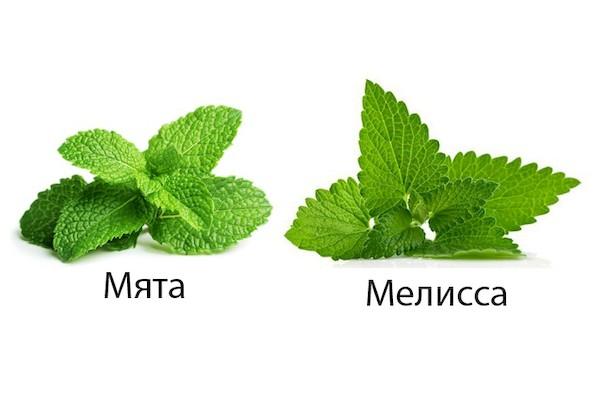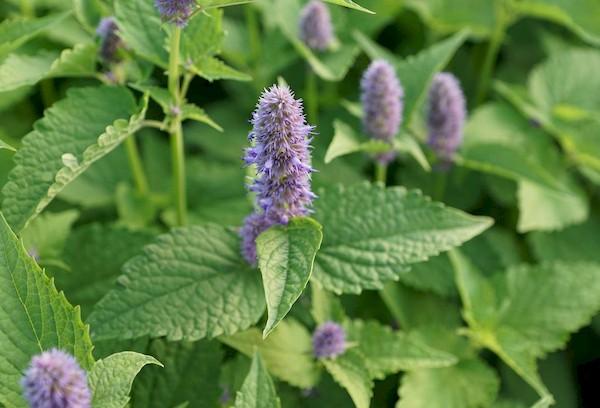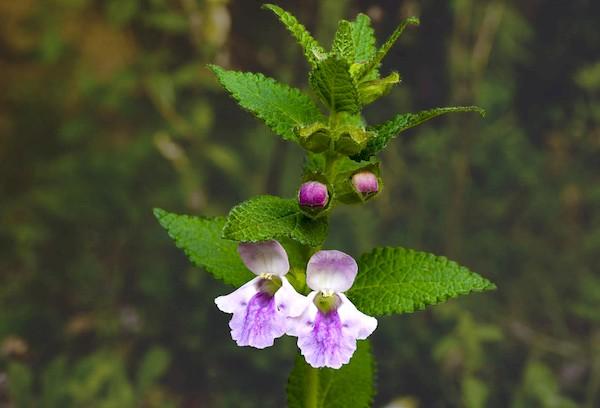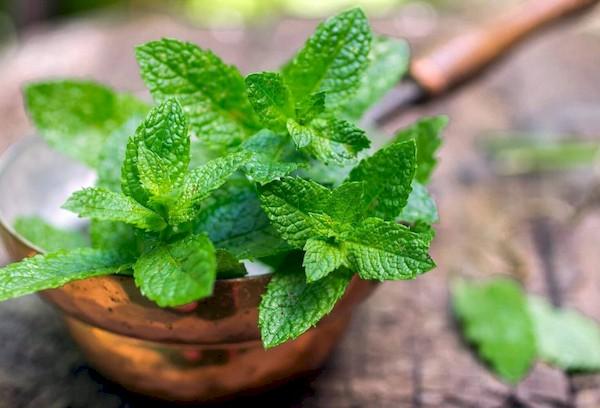What is the difference between mint and lemon balm?
The first and most obvious difference between mint and lemon balm is the smell. In mint it is menthol-like and strong. Melissa smells fresh mixed with lemons. Both plants are considered medicinal and have been used in medicine, cooking, and perfumery since ancient times. There are differences in their use, so it is important to distinguish the herbs.
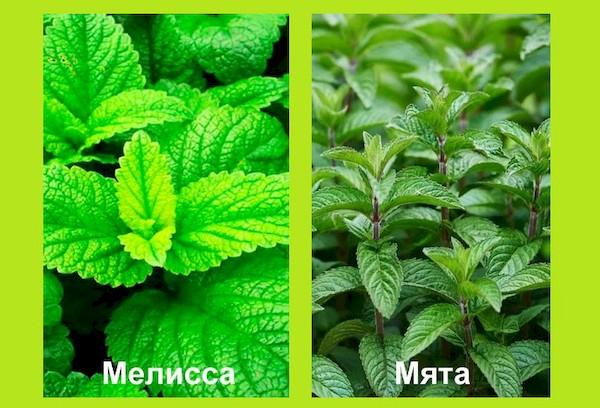
How to distinguish mint from lemon balm?
Mint and lemon balm are plants of the same family. They are very similar in appearance. Often gardeners themselves are not sure what is growing in the garden, lemon balm or mint. To notice the differences, you need to be careful and pay attention to the details:
- Melissa leaves are often larger, rounder, lighter in color and softer to the touch.
- Mint is rough, its leaves are more elongated, have a stronger and sharper smell.
- The aroma of lemon balm is reminiscent of citrus and disappears quickly.
- Mint bushes have erect shoots and quickly spread like a weed.
- Melissa is more compact, with almost white flowers located in the axils.
Difference in photo:
Comparison in the table:
| Mint | Melissa | |
| Aroma | pronounced menthol | thin lemon |
| Taste | sharp, scalding cold | fresh lemon |
| Main component | menthol | citronellal, geraniol and citronellol |
| Leaves | small, elongated, oval-pointed, often with purple veins, different green shades, harder to the touch (depending on the species) | large, round, rounded at the base, embossed, jagged, light green, tender to the touch |
| Application | Herbal medicine, aromatherapy, cosmetics, pharmacology, cooking and food products: mints, drinks, ice cream, sauces. As a spice it goes well with lamb and Indian dishes. Often used to flavor toothpastes, breath fresheners, and chewing gum.
Contains the essential oil component pulegone, a natural insecticide. |
Perfumes, cooking (except confectionery), official and traditional medicine. More often found in hair and body care products, flavored teas, and desserts.
|
| Effect on the human body | carminative;
sedative; choleretic; antiemetic; help with inflammatory diseases of the upper respiratory tract; antitussive; antiseptic; increases appetite; reduces headaches; relieves spasm of coronary vessels and smooth muscles.
|
mild sedative;
antiviral; pain reliever for migraines and painful menstruation; anticonvulsant; antimicrobial; antihistamine; diuretic; lowers blood pressure and slows heart rate. |
Video about the difference between mint and lemon balm:
What is mint?
The mint plant is written in Latin as Mentna.
According to legend, the name “mint” appeared on behalf of the nymph Minta or Minfa. She became the concubine of the god of the kingdom of the dead, Hades. Persephone, the mistress of the underworld, became very angry and trampled Minta, turning her into mint. In Ancient Greece, the plant was used for a long time in funeral rites. Mint is also a symbol of hospitality. It was scattered on the earthen floor to hide the characteristic smell.
Good to know. There are about 600 species of mint in the world, 14 of them are found in Russia. The most valuable species is peppermint, a hybrid of water mint and spearmint.
The plant grows quickly by rhizome, and is unpretentious to conditions (with the exception of peppermint). Can grow in both shade and sun. The leaves can be collected at any time, but the highest concentration of essential oils is observed during the flowering period.
Botanical features:
- Herbaceous perennial 30-100 cm high.
- The stem is branched, erect, glabrous or with sparse hairs.
- The rhizome is well developed.
- The leaves are crosswise opposite, elongated oval, pointed, with short petioles and a heart-shaped base.
- Blooms from June to September.
- The flowers are light purple, collected in half-whorls at the tops of the shoots, and forming spike-shaped inflorescences.
- Peppermint fruits appear rarely and consist of 4 nuts.
Mint can look different depending on the type.
Expert on the variety of mint:
What is lemon balm?
Melissa (the correct name is Melissa officinalis or lemon balm) grows wild in the Caucasus, Central Asia, and southern Europe.
Melissa is a famous honey plant. It has long been rubbed onto hives to attract bees. In Greek "melissa" means "bee" from "mel" - "honey". In ancient Greek mythology, the nymph Melissa was the ancestor and pacifier of bees. The ancient Greeks considered bees to be divine creatures due to the complex and organized activities within the hive. Melissas are also priestesses of Artemis and Demeter.
Botanical features:
- The perennial plant reaches a height of 30-100-120 cm.
- The shoots are branched, drooping, the lower ones are creeping.
- The stems are soft-fibrous, covered with short, delicate hairs.
- The rhizome is powerful.
- The leaves are opposite, ovate, serrated along the edges, covered with glandular hairs, embossed, with a pronounced network of veins.
- The foliage is light green.
- Melissa blooms almost all summer.
- The flowers are collected in a whorl, arranged in tiers and have a pale lilac, almost white color.
- The seeds appear in September and consist of 4 ovoid nuts. When ripe they become black and shiny. The weight of a thousand seeds is about 0.6 g.
Melissa is popularly called lemon balm for the citrus notes in the taste and aroma of the leaves.
The plant is often grown in gardens and cottages as an aromatic additive for tea and all kinds of dishes. Melissa is propagated by rhizomes. It is undemanding in terms of conditions and care, but in severe winters at the age of 4-5 years or more it can freeze out. Grows quickly and loves sun. In the shade, the intensity of the aroma decreases.
Melissa is most popular as a flavorful additive for desserts: berry jellies, mousses, jelly, compotes, as well as sweet porridges, gravies, omelettes. Fresh leaves are often used in smoothies, cocktails, cold summer soups, to flavor vinegar, and alcoholic beverages. It is well suited for dairy dishes in which lemon zest is not suitable due to its acidity.
The delicate aroma of lemon balm disappears at a temperature of 110 degrees.
Question answer
What plant are lemon balm and mint often confused with?
There is another very similar plant of the Lamiaceae family - catnip or catnip. Catnip has a lemon-mint scent, but is distinguished by heart-shaped leaves of a grayish-green hue. Catnip flowers are collected in panicles at the tops of the shoots and are not formed in the axils. Its odor is more persistent than that of lemon balm, but weaker than that of mint.
Which is better and healthier?
Melissa acts more effectively as a sedative; it makes tea, fruit salads, and desserts tastier and more enjoyable. Mint is a stronger flavor.Mint has a stronger antimicrobial effect and is good for nausea and headaches.
Despite their many differences, lemon balm and mint are often perceived as identical and interchangeable plants. They can be used together in landscape design. Combinations of several fragrant crops are popular: oregano, hyssop, thyme, fennel, lovage, tarragon, lavender. There is also a slight difference when using lemon balm and mint as a sedative and pain reliever. But in perfumery and cooking, herbs give significantly different results. Melissa is delicate, “noble” honey-lemon, and peppermint is sharp, burning menthol.
